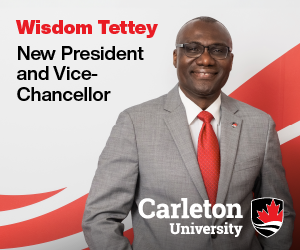All the Englishes used here
Let’s create learning environments where students who speak English as an additional language needn’t apologize for speaking up.

International students attending postsecondary institutions (PSIs) where English is the medium of instruction are often users of English as an additional language (EAL), generating innumerable dialects, forms and accents. Although these students meet the language proficiency requirements to study at their PSIs, they can face both explicit and subtle messages of native-speakerism. This language ideology holds that those who use English as a first language (L1) and/or monolingually characterize the optimal way to speak and write it. Consequently, “non-native” users are relegated to categories of lesser prestige, even though many of them have communicated in English in their home countries for years or decades.
Although internationally-educated and EAL students can absolutely benefit from tailored English language supports offered by their PSIs, the onus of linguistically acclimating often rests upon these students’ shoulders alone. And even so, racialized EAL students’ English language practices are especially scrutinized through unsolicited comments and corrections. Ideally, successful intercultural communication is predicated on mutual responsibility, but we must acknowledge that English serving as the medium for these interactions not due to neutral, ahistorical factors.
Those of us in student-facing positions also know that international and multilingual students can feel considerable pressure to adjust to their L1 peers. Indeed, international students frequently share anecdotes from their classrooms and labs where they navigate fast-paced turns, idioms and colloquialisms, conversational impasses, and other challenges. Some of them tell me that they choose to opt out of discussions entirely as a coping strategy to manage feelings of inadequacy. Worryingly, it is also common for these students to apologize for their English as a preamble to taking a turn. While this may be a useful strategy to signal ahead to their audiences, how can we strive for dynamics where individuals do not feel the need to say sorry just for speaking up?
Of course, if EAL students wish to adopt the standard(s) of their academic disciplines, social communities, and professional networks, we in teaching and advising roles must respect that. However, I suggest that a crucial piece is missing in this conversation, namely the responsibilities of L1 English users in alleviating some of the load that their EAL counterparts carry. Here are five areas where instructors, staff, and students using English as their L1 can channel their intercultural awareness into direct practice and create more welcoming spaces of learning and collaboration for EAL peers and colleagues:
1. Describing English as a linguistic process, not a fixed language
The English language is not a stable system. Instead, it should be approached as a linguistic process that is translingual. Scholars refer to this as Lingua Franca English (LFE), which does not have one singular form but is a dynamic language practice that is constantly remade from the multiple linguistic resources available to users – including their other languages – while interacting with others. Pluralizing “Englishes” also validates the many varieties of written and spoken English successfully used around the world. As such, instructors could include a blurb in their course outlines encouraging all Englishes and participation styles during classroom discussions and activities. Facilitators can set a similar tone by opening workshops that acknowledge and welcome any multilingual expertise in the space.
2. Normalizing clarification strategies
When LFE practices are in use, it is reasonable that additional time may be necessary for us to clarify, repeat, or change direction. Students working in groups might believe that drawing upon these strategies is evidence that their conversations are inefficient and going poorly. However, these acts of negotiating meaning contribute towards linguistically inclusive conversations because no one is assuming that one register or standard of English is privileged over another. Even beginning a turn with “Let me know if I can repeat or rephrase anything” can both normalize and invite clarification.
3. Training our ears
It is estimated that only four per cent of conversations in English take place between L1 users; the vast majority will include at least one EAL speaker. And as global communication specialist Heather Hansen notes, accent recognition is a lot easier than accent modification. Rather than expecting EAL users to conform to the “standard” norms and sounds of a minority, L1 users can expose themselves to a wide variety of accents and dialects. One resource that they can access is the International Dialects of English Archive, which offers audio excerpts of individuals speaking English from across the globe.
4. Adjusting our speaking in subtle but impactful ways
When we wish to establish rapport with an audience, we might inadvertently use culturally specific idioms, acronyms, or slang. While we shouldn’t avoid these phrases and words entirely, we can explain what we mean in plain language immediately after using them. Also, adding intentional pauses wherever possible gives all students regardless of their relationship with English the time to translate, process, rehearse, or simply sit with an idea before responding.
5. Committing to deepen and share our knowledge of LFE and Englishes
Changing Englishes is an open-access course for instructors and student-facing staff that provides theoretical frameworks and practical suggestions to facilitate more equitable communication using Englishes.
Striving for intercultural responsibility in Englishes on our campuses prompts us all to move beyond the binary of “native” and “non-native” language users. What is possible when we collectively choose to focus on the rich plurilingual strengths that are found between these absolutes?
This column is coordinated through the Internationalization of Student Affairs Community of Practice of the Canadian Association of College & University Student Services (CACUSS). For comments or questions please contact in***********@ca****.ca.
Featured Jobs
- Psychology - Assistant Professor (Social)Mount Saint Vincent University
- Indigenous Studies - Faculty PositionUniversité Laval
- Accounting - Tenured or Tenure-Track Faculty PositionUniversity of Alberta
- Electrical and Computer Engineering - Assistant/Associate ProfessorWestern University
- Electrical Engineering - Assistant Professor (Electromagnetic/Photonic Devices and Systems)Toronto Metropolitan University















Post a comment
University Affairs moderates all comments according to the following guidelines. If approved, comments generally appear within one business day. We may republish particularly insightful remarks in our print edition or elsewhere.
2 Comments
Brilliant article with 5 practical strategies that all faculty & staff in post-secondary ed should use to level the playing field for speakers of all the Englishes. Building skill in accent recognition would be a great start for all of us.
I am always impressed by students who are EAL speakers as languages have always been difficult for me. As I teach writing – academic writing – among other courses, this subject is always at the forefront of my mind. It’s actually one of the reasons that I insist on formal, academic writing – free of jargon, idiom, etc. My experience of EALs is quite different than that depicted here, During covid, I saw an even greater issue of students understanding and being able to communicate in English because they were no longer in an English-speaking environment. Even while in-person, EAL students tend to stick together and not speak English. They translate instructions to their first language, do the assignment, and translate it back. This rarely (if ever) satisfies the assignment. At least part of the problem rests with the language “proficiency” tests which clearly do NOT set these students up for success. There needs to be a much higher standard for these students for them to be able to truly succeed as EALs and not simply be a source of revenue for the various institutions.